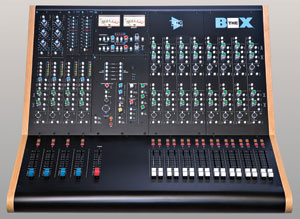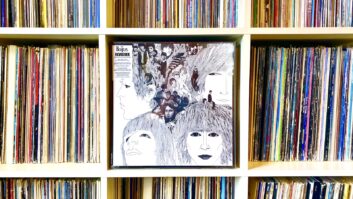
We all know the API brand from the 1970s classic consoles, Lunchbox series processors, Legacy, Vision and 1608 desks. It’s safe to say that API has a reputation for building recording consoles and outboard equipment that deliver a recognizable thick, warm analog sound. It is an “expensive” sound that, for a long time, was financially out of reach for most. While the Lunchbox made it possible to get “that” API sound, it was still a long reach to a full API console. With the introduction of THE BOX, API has landed in the mid-ground, finally manufacturing an affordable, small-footprint console.
Outside THE BOX
THE BOX is a very cool vintage-looking, small-format recording/mixing console. In a way, it harkens back to the old split design. Channels 1 and 2 have a 550a 3-band EQ each, while channels 3 and 4 have free 500 Series slots, allowing you to customize that part of the console. In addition, all four recording channels have insert send and return points to hook up your favorite outboard processors.
The mic pre is the same as that used on the 1608 and offers +35dB of gain; 48V phantom power; phase reverse; a Mic/Line/Instr selector; a smooth 50Hz, 6dB/octave highpass filter; insert bypass switch; compressor pre/post; and a pad to reduce the mic input sensitivity by 20 dB and the Line input by 6 dB. It leaves the Instrument input unaffected.
There’s also a useful 8-segment LED meter that you can switch between preamp-out and post-fader to keep an eye on your input levels. The Direct Pre switch allows you to bypass the fader section and send the preamp signal to the direct output.
THE BOX provides two mono aux sends and a stereo cue send. Each pair of the sends has pre/post-fader switching and a bypass switch. The stereo aux send can be routed to feed into the stereo cue bus instead of aux buses 3 and 4. To accommodate the four sends, THE BOX is equipped with four auxiliary buses and a stereo cue bus, each with corresponding masters.
Each channel has a dedicated, center-detented pan pot; a program bus assign switch, feeding the signal to mix bus; and a Safe switch, putting that particular channel in solo safe mode. The faders are 100mm long-throw API proprietary, each with its own solo and mute buttons.
Cool Summer
THE BOX has 16 input summing channels, giving you the opportunity to mix on long-throw faders from your DAW. Each channel is identical and comes geared with the faders, including their mix bus routing, insert, solo, and mute switches; the same Aux and Cue sends you have on the recording channels; pan pots; and a 0dB fader bypass switch.
The 0dB switch is just like setting the fader to unity gain with the fader bypassed while all other channel functions continue to operate normally. For the purists, this also slightly shortens the signal path, while providing full channel functionality. The return channels come in pairs, side by side, and all the Aux/Cue/Pan controls are laid out above each other, making good use of the space.
Center of Attention
Any console worth its salt comes armed with a master section, and THE BOX’s is probably its most powerful feature. Obviously, this is where the master program fader lives. The Aux/Cue masters, headphone level, and talkback microphone and controls reside here, as well. You have control over the talkback level by means of a gain pot and three further calibration trim pots, and you can feed the electret talkback mic to the Slate, the Auxes and Cue sends.
The headphones can be switched off, and Cue mix output can be routed to the headphones to replace its default main mix setting. At all times, the headphone feed is sent out to two very useful headphone sockets.
The solo master section comes equipped with a trim control and a couple of switches that flip between AFL and Solo In Place and Solo Clear. The control room part of the master panel sports the classic API big control-room knob for the main speaker level. The Alternative speaker switch and trim control allow you to set up a secondary set of monitors, and the Cut, Dim (with dim attenuator), Mix Insert and Mono switches complete this well-laid-out monitoring section.
The Control Room Source selection switches give you the option to monitor either the main program mix bus or four sets of 2-track stereo inputs. The same goes for the Cue Sources. THE BOX can route the Program bus and the four 2-tracks to the cues.
One important thing to be aware of is that the Cue sources are additive. This means that you can route the main console mix and all four stereo inputs to the cue bus. That is not so for the Control Room sources. You can decide to monitor each of the four 2-tracks individually or combined or the Program mix feed. Once you select the console output to be monitored, the 2-tracks are bypassed.
The Main Squeeze
Compression plays a major role in most recording and mix setups, and THE BOX is loaded with an integral API 527 stereo bus compressor. The default setting is inserted in the main bus; however, this bad boy can be unlinked and routed to the recording channels, so you can track with compression.
If you’ve used the 2500 or The Channel Strip compressors, you’ll feel right at home. The 527s sound and behave in a very similar way and have the same controls: routing, bypass, threshold, ratio, attack, release, soft/hard knee and link switches. As with the 2500, you can select between Old and New style of compression. The Old style uses “feedback” compression found in the more vintage units like the 525, while the New style employs a “feed-forward” type where the compressor’s sidechain is fed directly from the input.
API’s patented Thrust circuitry has also been added to THE BOX 527 compressor design. Thrust inserts a highpass filter into the compressor’s detector, reducing the low frequencies that pump and giving you a punchier sound. This is a very smooth and transparent compressor. It’s great for tracking and lovely and soft on full mixes. Personally, I’d have liked to see a faster release control à la the 2500 to give you more punch for more aggressive work.
In Session
I visited the API factory for the review and had anticipated a very small, stripped-down version of an API. Instead, I came face-to-face with a slick, extremely professional-looking console. To begin the test drive, I rigged up Pro Tools, running through a Universal Audio Apollo and a couple of Focal monitors.
The connectivity on the back of THE BOX is straightforward and well laid out.
The mic pres come in on XLRs; the Line, Inserts and Instrument inputs accept balanced and unbalanced jacks, respectively. DB-25 connectors provide access to the direct outputs, mic pre outs, Aux outs, 2-track inputs and the 16 summing inputs. The Main and Alt monitors and the Program Sum input are all on XLRs.
I immediately wanted to get my hands on the faders and find out what this beast sounded like. Rather than starting out by checking out the recording path, I decided to load up a new Elliott Randall track I’m working on. We typically finish our projects through API gear, so this was the perfect time to see how THE BOX compares to the vintage API we’re used to.
As THE BOX comes with two empty API 500 series slots, I ventured out into the warehouse and found myself two extra JDK V14 4-band equalizers. Popping those in is as easy as installing a new unit into your Lunchbox.
I brought everything out of Pro Tools into the 16 return channels, pushed the faders up, and there was the unmistakable warm, yet crisp and clear API sonic character. To demonstrate that you don’t have to stick to the 16 return channels for mixing, I cross-patched four of the outputs into the recording channels so that I could use the 550a EQs, make use of the additional 500 Series slots and, more than anything, switch the bus compressors into channels 1-4. The results were stunning. Within seconds, I got that classic, fat analog sound. Even returning reverbs and delays from the DAW through THE BOX smooths them out.
The DAW in this instance ended up being a tape machine. All I used it for was to play back the files and generate some of the effects. All the EQing, balancing and compression was done on the API. Elliott Randall and I liked the mix created on THE BOX so much that we decided this is the mix that will be released. Client pleased, engineer very happy. Box ticked.
I also wanted to hear how THE BOX performed on material with vocals. I had some backing vocals to overdub for an Underground Ally album, so I took this opportunity to put the recording channels through their paces. Again, within minutes I had a lovely warm mix ready to sing to. I rigged up a condenser and pulled in a JDK 8MX2 to feed the auxes and cues into, and I had myself a cool headphone mixer to test the fold-back functionality. The mic preamps sound amazing. They have tons of headroom and sound thick. The highpass filter cleans up pops and rumble, and the mic pre, EQ and compressor combo is fantastic for recording.
Summing Up
The console is very well laid out. Having the sloping back makes working a lot more comfortable. It sounds and looks great. Having a big chunk of API as the centerpiece in your studio setup is bound to impress clients. If there’s one thing to moan about, it would be the Control Room source selectors—if they could be additive, like the cue sources, this desk would provide you with 30 inputs instead of its current 22. However, that may just be me being channel greedy.
API has created a truly amazing piece of equipment. Overall, I am blown away by this well-engineered sonic beauty and its value for the money. If you were to buy four API pre’s, two 550a’s, two more API 500 Series modules, an API stereo compressor, a monitor controller and a couple of fader packs, you’d end up paying a lot more!
Anyone serious about recording and mixing who is working in the box and is thinking about upgrading or changing consoles, or is simply on a quest for great analog sound, get your hands on THE BOX.
Wes Maebe is a London-based engineer/producer/musician. Check out his work at www.wesonator.co.uk.
Try This
If you’ve run out of inputs on THE BOX in mix mode, run your external summing mixer outs into the four 2-track inputs. Activate the four Cue Sources and patch the Cue output (3-4) to the Program Sum inputs. You’re now summing an additional eight inputs into your console, turning it into a 28-channel desk.
Product Summary
COMPANY: Automated Processes Inc.
PRODUCT: THE BOX
WEBSITE:www.APIaudio.com/THEBOX
PRICE: $17,995
PROS: Great sound. Elegant and ergonomic design. Affordable. API Warranty (one year factory service plus five years on all parts).
CONS: Non-additive Control Room source switching. Slow-ish compression release time. No signal indicators on the 16 return channels.






